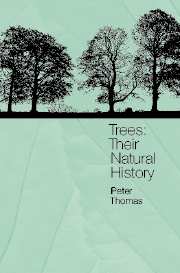Book contents
- Frontmatter
- Contents
- Preface
- 1 An overview
- 2 Leaves: the food producers
- 3 Trunk and branches: more than a connecting drainpipe
- 4 Roots: the hidden tree
- 5 Towards the next generation: flowers, fruits and seeds
- 6 The growing tree
- 7 The shape of trees
- 8 The next generation: new trees from old
- 9 Health, damage and death: living in a hostile world
- Further reading
- Index
7 - The shape of trees
Published online by Cambridge University Press: 05 September 2012
- Frontmatter
- Contents
- Preface
- 1 An overview
- 2 Leaves: the food producers
- 3 Trunk and branches: more than a connecting drainpipe
- 4 Roots: the hidden tree
- 5 Towards the next generation: flowers, fruits and seeds
- 6 The growing tree
- 7 The shape of trees
- 8 The next generation: new trees from old
- 9 Health, damage and death: living in a hostile world
- Further reading
- Index
Summary
The whole point of a woody skeleton is ultimately to get the leaves above competitors to ensure a lion's share of the light. And from this simple goal comes an enormous range of tree shapes, from the unbranched stems of palms and tree ferns to the tall spires of conifers, the broad spreading crown of oaks and the multiple stems of an old yew. What governs the shape of trees? How are trees organised to display what often looks like an impossibly large number of leaves?
Trees of distinctive shape
It is usually possible (but not always!) to identify a conifer from a distance by its conical outline. Within the cone there are usually plates of foliage showing where the branches are produced in whorls around the main central stem, usually one whorl per year (Figure 7.1). This contrasts with the rounded dome of a hardwood where the initially leading shoot of the young tree gives way to a number of strong branches, giving the whole canopy a rounded shape.
Within these two main shapes it is possible (with a little practice) to distinguish different species simply by their shape. This book is not the place to list the distinctive features of common species but one example will illustrate the point. In common lime (Tilia × europaea) the main branches develop in great arching curves, which in time lose the terminal buds.
- Type
- Chapter
- Information
- TreesTheir Natural History, pp. 187 - 212Publisher: Cambridge University PressPrint publication year: 2000
- 1
- Cited by



